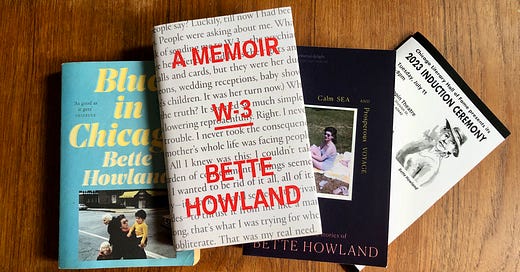A few posts back I mentioned that had been asked to say a few words about memoirist, short story writer, and critic Bette Howland at a ceremony honoring Howland, Harlem Renaissance novelist Nella Larsen, and turn-of-the-last-century humorist Finley Peter Dunne. Well, that ceremony was last night, and it was for the most part pretty lovely.
Held at the Chopin Theatre, the thrift-store-roccoco home for much of the work I’ve done with Theater Oobleck over the past two decades, the ceremony was put on by the Chicago Literary Hall of Fame, an organization that sounds fancier than it is. Its mission is to honor and preserve Chicago’s literary heritage, through events like this as well as educational programming, readings, and the like. The only criteria for inclusion in the HoF is that the writer in question have contributed with some significance to the literary culture of the city, and that they be dead.
I was surprised and pleased to be asked to participate, and over the past month I have become a Bette Howland convert: if you are not familiar with this remarkable writer’s compact body of work — and you’re probably not tbh — you really should be. Her memoir W-3 sits between The Bell Jar and Girl, Interrupted in the canon of women's writing about mental illness and institutionalization. I would say her short stories are jewels — glittering, sharp, with multifaceted depths — except jewels are too rich for her blood, so maybe they are better described as the most perfect pieces of beach glass, or agate. Long out of print, her work has been brought back into circulation thanks to Brigid Hughes, the editor of the literary magazine and small press A Public Space, who found a copy of W-3 in a bargain bin a few years ago, and went down the Howland rabbit hole.
The pressure was on for this presentation because I knew Howland’s two sons, Frank and Jake, were going to be in the audience and also say a few words. I did not want to let them down! But they were both kind and appreciative, and each of their wives — very charming! — pulled me aside to tell me later that they thought Bette would have approved. An old friend of hers was also in the crowd, and she told me that she thought I really “got” her. So, mission accomplished.
Writer Rachel Swearingen read a selection from Howland’s autobiographical short story Public Facilities (she worked as a librarian in Uptown for a time), and I was glad to get to chat with her and other folks like Jennifer Smith, Kathleen Rooney and June Sawyers. And Chaz Ebert! The only rough spot was when one of the other presenters, actor Mike Houlihan — with the eternal confidence of a man who cannot conceive of a world in which the audience is not on their side — made a transphobic joke about pronouns. I contemplated saying something when it was my turn at the mic. I should have, but I did not want to distract from the honor being paid to Howland and her family by giving it any more air. So I’m saying it now: that was not OK, and I don’t want to be on a program with anyone who thinks it is. Next time, I’ll do some more vetting before I say yes.
However! As I said, overall: lovely. After Rachel’s reading Frank Howland spoke eloquently of his mother, her glory and her struggles. It was very moving, and I was not the only one wiping away a tear. I got the brothers to sign my copy of W-3 when it was all over, giving me one more reason to cherish that book.
I’m sharing my brief remarks below. Go read some Bette Howland! You won’t be sorry.
When I’ve told people these past few weeks that I had been asked to speak about Bette Howland at this ceremony I’ve been met, unilaterally, with blank stares. Maybe a slight furrowing of the brow, as the person I’m speaking with searches their brain, or my face, for clues.
“She’s like the Connie Converse of the Chicago literary scene,” I’d say, helpfully – but that’s only really helpful if you know who Connie Converse is and, it turns out, most people don’t know who she is either. Connie Converse was a singer-songwriter ahead of her time – though hailed as the “female Bob Dylan” in the 50s and 60s, she never found commercial success, and vanished without a trace in 1974, but her work has been enjoying a renaissance of late.
Like Converse, Howland was also a woman – a single mother of two – trying to make a name for herself as an artist in the male-dominated culture of the middle of the 20th century. Like Converse, she disappeared from public view and was, for a time, forgotten. But, really, the comparison stops there. Because Bette Howland was not ahead of her time, she was utterly OF her time. Her ability to evoke a powerful, precise feeling of place and moment – Chicago, in the 1970s, more or less – is key to what makes her writing so compelling today.
Keep reading with a 7-day free trial
Subscribe to Range of Motion to keep reading this post and get 7 days of free access to the full post archives.




